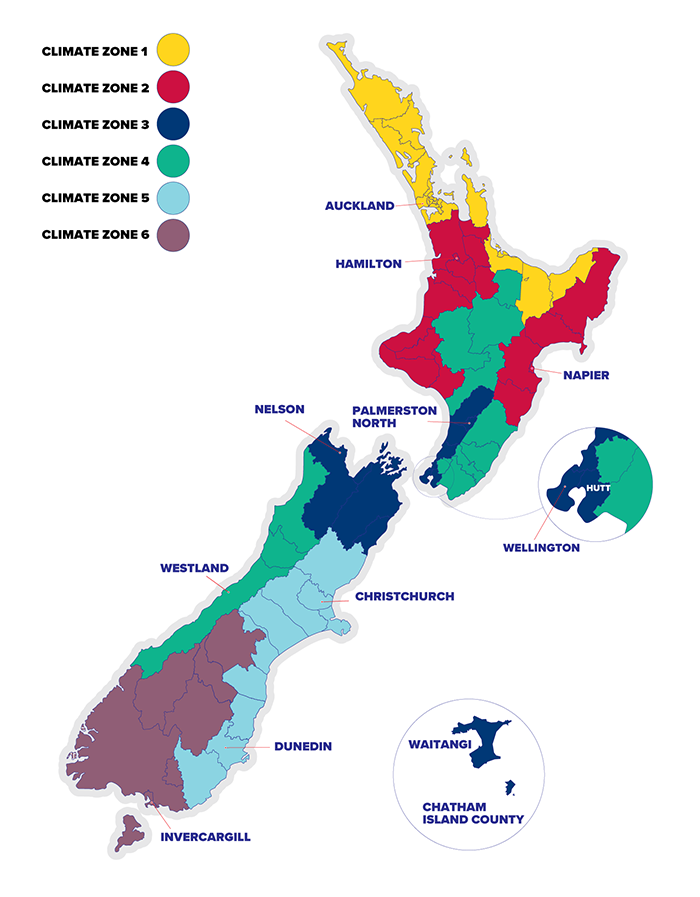Understanding Energy Efficiency (H1) Requirements
The Ministry of Business, Innovation and Employment (MBIE) has updated the Energy Efficiency (H1) requirements for insulating new homes and commercial buildings in the NZ Building Code. The purpose is to reduce energy needed to heat new buildings by up to 40% and help make them warmer, drier & healthier, with less impact on the environment with significant changes taking place firstly in November 2022 and a further set of requirements beginning from May 2023.
The H1 Clause of the Building Code regulates the energy efficiency of the built environment – covering wall, floor and ceiling insulation, as well as the thermal performance of windows and doors. There are major increases in thermal performance requirements across the building envelope, indicated through higher construction R-values for different building elements.
New Climate Zone
With a focus on energy efficiency, these H1 updates are explained by the introduction of additional climate zones. This will allow the insulation requirements to better reflect the different temperatures experienced through the different regions within NZ:

New housing and building under 300m2 insulation requirements
The new housing and small building insulation requirements are the same. The only difference between them is the transition date for the new final values to come into effect.
For ‘Buildings under 300m2’, the new requirements came into effect on 3 November 2022. For housing, the new requirements were pushed back for six months, meaning they come into effect on 1 May 2023.
The only exception is category is ‘windows and doors’, which retained its original two-stage implementation – with the first on 3 November 2022 and the second on 2 November 2023.
The 5th editions of H1/AS1 and H1/VM1 include new methodologies for establishing the thermal resistance of windows, doors, skylights, curtain walling and slab-on-ground floors. From 3 November 2022, only the new methodologies can be used (with the exception of slab-on-ground floors).
However, until 1 May 2023, building consents for ‘Housing’ can use the “old” minimum construction R-values for roofs, walls and floors – those in the 4th editions of H1/AS1 and H1/VM1.
Below is an overview of the minimum R-values for each building element for housing in H1/AS1 and H1/VM1:
Minimum R-values for each building element for housing in H1/AS1 and H1/VM1
| Options | Climate Zone | |||||
| 1 | 2 | 3 | 4 | 5 | 6 | |
| Roofs | ||||||
| Current minimum requirements | R2.9 | R2.9/3.3 | R3.3 | |||
| 1 May 2023 | R6.6 | |||||
| Walls | ||||||
| Current minimum requirements | R1.9 | R1.9/2.0 | R2.0 | |||
| 1 May 2023 | R2.0 | |||||
| Floors | ||||||
| Current minimum requirements | R1.3 | |||||
| Slab-on-ground floors 1 May 2023 | R1.5 | R1.5 | R1.5 | R1.5 | R1.6 | R1.5 |
| Other floors 1 May 2023 | R2.5 | R2.8 | R3.0 | |||
| Windows & Doors | ||||||
| Previous minimum requirements | R0.26 | |||||
| 3 November 2022 | R0.37 | R0.37 | R0.37 | |||
| 1 May 2023 | R0.37 | R0.46 | R0.50 | |||
| 2 November 2023 | R0.46 | R0.46 | R0.50 | |||
It’s important to note that meeting these R-values is based on using the Schedule Method for compliance. See more on the Schedule method and when it can be used HERE. When using the Calculation or Modelling method, individual construction element R-values may be higher or lower depending on several variables.
Buildings more than 300m2
The new requirements for large buildings aim to reduce the emissions and energy used when heating and cooling a larger building by 23% on average over previous minimum status quo requirements.
This overview of changes applies to ‘Buildings greater than 300m2’, including but not limited to buildings classified as offices, retail, schools, hotels, restaurants, etc. The specified area – greater than 300m2 – is based on the occupied space of the building.
These changes only affect new construction or existing properties undergoing changes to the external thermal envelope, which will require a building consent.
Industrial buildings are not currently required to be energy efficient so sit outside the scope of this work. However, if there was an office within a warehouse, or an industrial building, that office would have to comply with the updated requirements.
What’s changed?
MBIE changed the roof, window, wall and underfloor insulation requirements for buildings larger than 300m2. These changes are outlined in the table below.
Increases in minimum R-values for large buildings
| Options | Climate Zone | |||||
| 1 | 2 | 3 | 4 | 5 | 6 | |
| Roof | R3.5 | R4.0 | R5.0 | R5.4 | R6.0 | R7.0 |
| Window | R0.33 | R0.33 | R0.37 | R0.37 | R0.40 | R0.42 |
| Wall | R2.2 | R2.4 | R2.7 | R3.0 | R3.0 | R3.2 |
| Underfloor | R2.2 | R2.2 | R2.2 | R2.4 | R2.5 | R2.6 |
Sources:
Bunnings Warehouse – https://trade.bunnings.co.nz/campaign/healthy-homes-h1
Placemakers – https://www.placemakers.co.nz/online/building-code-update-energy-efficiency-h1
Building Performance– https://www.building.govt.nz/building-code-compliance/h-energy-efficiency/h1-energy-efficiency/#jumpto-updates
Further reading:
